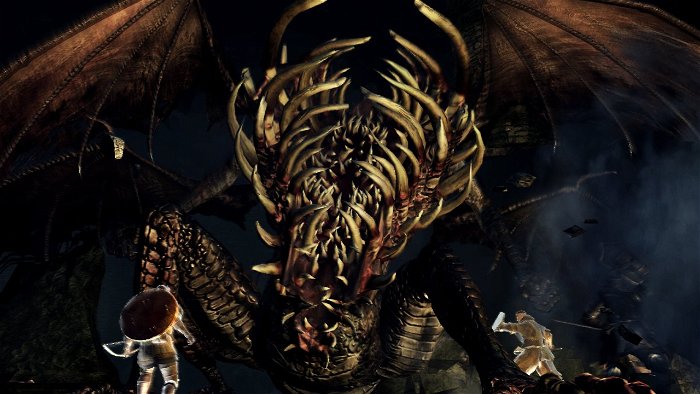I love October. I love the autumn weather, the colours on the trees, and, most of all, Hallowe’en. To celebrate this most spooky of holidays I’ll be discussing topics related to horror each week of the month in a series of editorials called . . . OCTERROR!
***
Dark Souls isn’t traditionally considered a horror game, but I have no idea why this is the case. Everything about From Software’s notoriously difficult action/role-playing game is terrifying. Its world is bleak, its enemies are grotesque, and the entire experience is centred around the player character dying in a million different ways.
So why isn’t it referred to as horror?

The newest trend in horror game design — one made popular by Frictional Games’ fantastic Amnesia: The Dark Descent — involves taking weapons away from players. It’s a good idea and one that helps compensate for the feeling of power that being able to gun down terrifying monsters imparts. But it’s also not the only way to create a sense of hopelessness in a horror game. In the past, the awkward controls in series like Resident Evil or Silent Hill came together with limited supplies, spooky environments, and disturbing creatures to make every enemy encounter a frightening experience. The problem was that they weren’t as much fun to play as contemporary games that handled better. But, as both series improved their mechanics, they became far less scary. So now it’s assumed that the best horror games should only give players either extremely ineffective weapons or none at all.
Games like Dead Space have tried to side-step this type of design by returning to the forced item scarcity that made early survival horror games tense. But the bombastic action and in-your-face monsters haunting the series’ derelict spaceships often take away from any real sense of terror. Dark Souls, on the other hand, manages to provide players with plenty of weapons and spells while maintaining a true feeling of horror. Part of this comes from just how vulnerable the game makes its main character. Despite having a powerful sword and a full supply of fireballs, one wrong step can allow even the weakest zombie to take down a momentarily absent minded warrior.

Death is everywhere in Dark Souls, from its mechanics down through to its setting. The sky is almost always overcast, the sun barely poking through ominous grey sheets of cloud. And once inside, the interior environments span such classically creepy locales as dungeons strewn with torture instruments to dark, dripping caves covered in skeletons. The enemies, no matter how closely they’re examined, never lose their impact. Pillars of animated bones, giant plague-ridden rats, and nightmare dragons stalk Dark Souls‘ world, all ready to not only kill the player character, but disturb her or him as well. The survival aspect of early horror games is also used to good effect in the game. It would be frightening enough to simply be killed by the blade-wielding, goat-headed Capra Demon, but Dark Souls takes things further by putting players up against the deadly monster with a limited supply of healing items and the potential to lose their stored souls (or experience points) if they are unlucky enough to be struck down by the beast.
The game’s various, meticulously crafted elements all come together to fill every moment spent in Dark Souls with dread. Because of this, it doesn’t matter that the player may be a knight kitted out with armour, sword, magic, and crossbow. They’re still helpless when thrown into the game’s brutally unforgiving world. This type of design defies the pacific convention established by Amnesia, Outlast, Slender, and other horror games that instill a sense of vulnerability by refusing to provide a way to fight back against aggressors. Giving the player weapons doesn’t mean that they can arm themselves against fear. Dark Souls fully understands this and that, combined with its macabre aesthetic, makes it fit perfectly within the horror genre.




